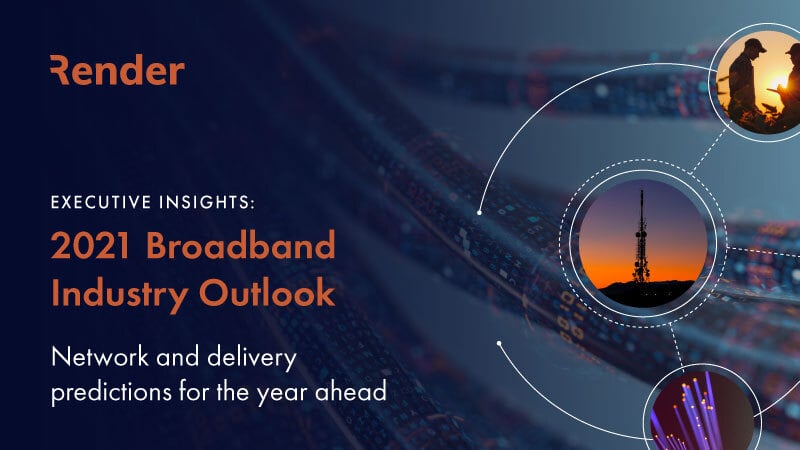
Fiber Network Deployment
2021 Broadband Industry Outlook - Part 1: Investment, Planning and Partnerships
The extensive digital transformation triggered by the COVID-19 pandemic has overhauled the way fiber and wireless network operators think about their long-term goals and short-term plans, a panel of industry experts has concluded.
Render, in partnership with ISE Magazine, brought together a team of policy, engineering, deployment and technology leaders, for a wide-ranging discussion on the key issues impacting the telecommunications infrastructure industry and their outlook for the sector in 2021.
The panel’s forecast:
The industry has a huge task ahead of it, investment is less of a hurdle however there are a new set of challenges on the rise. A universal appetite to think creatively and explore all possible partnerships, models, and tools that will enable more efficient and effective planning and delivery of network infrastructure is critical.
“Whatever network model people choose to deploy, connecting people so that they're making a contribution to the global conversation is really what’s at the heart of it and what matters the most.” Corning’s Market Development Manager, Kara Mullaley, said.
This is part one of the 2021 Broadband Industry Outlook highlights series covering key themes around investment, considerations for network strategy and planning, and how partnerships are accelerating the ability to plan and deliver these critical networks.
1 | Network Investment: Explore all available funding options and resources
One area where there has been a distinct shift in the debate is network investment. While there has been an increase in Federal funding, municipal bonds, and State grants there are more funding vehicles in play beyond traditional methods. Lower-risk mechanisms such as private equity, public-private partnerships, and low-interest loans are becoming more prolific.
Corning’s Kara Mullaley says private investment and community-based funding is becoming a viable option for securing the resources needed for these projects.
“Networks can be built and managed without grant money in a number of cases. Try to keep an open mindset, don't lock in on a particular way of funding and, be innovative and open to partnerships. I think that that will be key going forward.”
Federal broadband grants, however, still play a huge role in the funding of these projects. The panel agreed there would be “big money for deployment” coming out of the newly formed Biden government and equally there needed to be greater reforms around the application for, and utilization of these funds and grants.
“If we just keep spending this money the same way that we've been spending it, we're not going to get very far, we need a change in mindset,” Isak Finér, CMO and VP North America, COS Systems, says.
“There’s a requirement to make federal-based grants more accessible to state and regional broadband providers. This is vital, he shares as States and regional players have a better understanding of local needs and can navigate the unique challenges of each rollout.
Render’s Sam Pratt added: “There’s a large amount of funding that is searching for yield right now. Fiber networks are now considered infrastructure investment-grade and increasingly are attracting a broad range of suitors from outside of telecommunications. I think that's tremendously exciting for the year ahead.”
Further to this, Finer says, “The US market is ripe for investment, there are many entities wanting to step in and do something about digital inequality, and invest in something they believe in. We have seen infrastructure investors coming from Europe into the U.S hoping to replicate the same revenue and payback as other markets once the network is established.”
Listen to the panel's network investment predictions below, go to 11.26 or view chapters.
2 | Network Strategy & Planning: Plan with the end in mind, and future-proof from inception
The coming year, panel members agreed, will be a time of reinvention as networks consider what kind of business they want to become, and build a network that is multi-purpose. Balancing the need for basic connectivity with the network’s opportunities and fiber backhaul capacity to support future use cases such as smart-grid monitoring, power optimization, smart applications, and more.
“You have to know what you want your network to be,” Mullaley said, “because that will inform your strategy. Understand what it is you need, identify people that will look in your blind spots, and find smart friends who have done it before. Then look at the risks, and understand whether you are capable of building the network that you desire.’
According to rural broadband advocate and Associate Professor at University of Virginia, Christopher Ali, that all starts with consulting the community and creating a rollout that’s bespoke to their needs.
“The role of counties and municipalities has become increasingly important,” he says. “We call it broadband localism where communities and cities need to understand exactly what they need out of their network. Then they can play an active role in steering delivery requirements and investment.”
Render’s Sam Pratt added that a build strategy can be often be lost in the strategic planning process. Understanding where to build based on priorities or census blocks and equally being able to accurately measure performance in line with these objectives is where geospatial technology can play an essential role.
“A build strategy should be highly responsive to demand and the competitive environment over the course of a multi-year deployment. There are digital tools with in-built flexibility mechanisms to not only meet the daily objectives, but the long-term objectives of the project.” he says.
The panel shared the following checklist for network teams embarking on network planning:
+ What kind of applications and services do you want the network to serve long-term?
+ What are the risks and constraints? Supply chain interruptions and labor shortages require longer lead times and reliable partners. Do you have the internal capability to operate communications networks or smart utilities vs outsourcing?
+ What’s informing your RFP? With a myriad of inputs to decide upon - labor, material, architecture, and systems - each one of these not only has a financial impact, but also a network performance and customer experience impact.
+ What technology and tools are available to efficiently plan, design, deliver and operate your network.
+ What does best practice look like? Find partners to share planning and delivery best practices based on successful projects.
3 | Partnerships: Smart collaboration is key to bridging the digital divide
Any network build will typically get off the ground faster with the right partnerships in place. The panel confirmed that funding, delivery and vendor partnerships are possibly the most powerful and effective tools we have to stand up more rollouts across the country this year.
“It is going to take a village to do this right, to cross the digital divide successfully,” Corning’s Kara Mullaley said.
However, partnerships are taking new and interesting forms. We’re starting to see more public, private partnerships, as well as community-driven partnerships with corporates.
“Electric cooperatives are starting to move a lot faster with their deployment plans,”
Christopher Ali said. “This will really take shape with delivery models between cooperatives and other ISPs or public entities. This is going to be particularly important for rural areas where larger providers just aren't servicing the communities.’
Ali also said: “Partnerships between counties and municipalities need a digital champion or champions who will proactively identify and approach neighboring cities that may be open to collaboration, resource sharing and partnering to connect their respective communities.”
A fiber rollout partnership in Springfield, Missouri between Render, City Utilities, The Broadband Group, and Lumen (previously known as CenturyLink) became a focal point for this topic.
Render’s Sam Pratt says the partnership worked because “ there's been quite a bit of humility in the planning process.”
“There’s been a willingness to defer to the domain experts throughout the process and to drive innovation at each stage of the project. Alignment and focus on digital and its role in the broader vision to deliver best-in-class customer experience to the residents of Springfield”
To close out these initial trends, Christopher Ali said:
"No model or approach should be discounted. This includes municipality, cooperative and county partnerships, open-access, and innovative approaches and models. Even if you don't realize you're a stakeholder in the digital divide, you need to be and it is so crucial that we don't discount anyone from the conversation."
We are excited to share part two of the 2021 Broadband Industry Outlook highlights series next week covering Government policy predictions, and the role of innovative business models, emerging technologies and efficiency tools to better plan, construct and manage your network infrastructure.
Industry Panel:




Missed the 2021 Broadband Industry executive forum?
Register below to receive the session on-demand:


